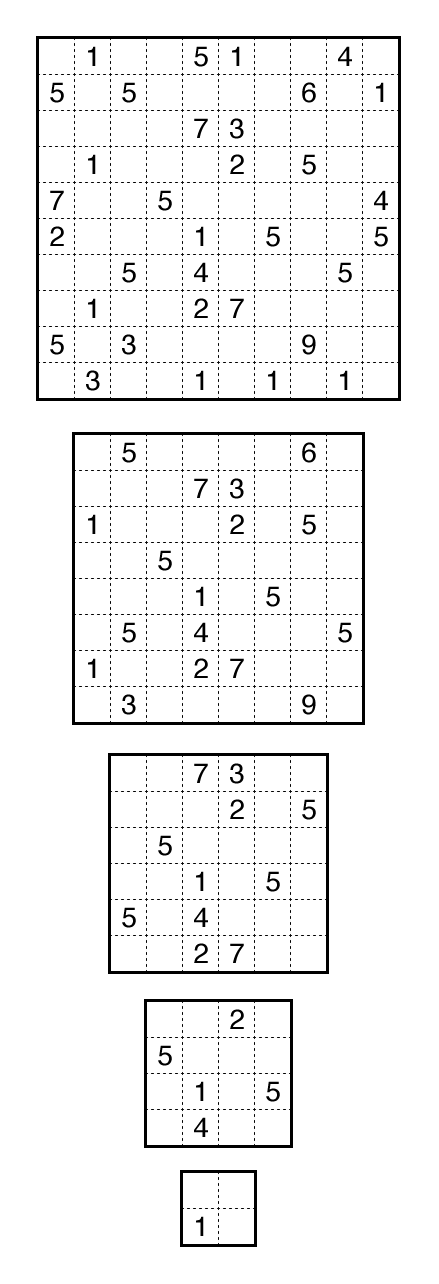Sunday Surprise #9 – Matryoshka Fillomino
Today’s surprise comes from Nikolai Beluhov, a graduate student of mathematical logic who has been sharing some creative puzzle ideas with me recently. Some of them have ended up on his new puzzle blog Puzzled By Titles. This puzzle has become a Sunday Surprise.
Much like a set of Matryoshka dolls, this Fillomino is a puzzle with many layers. Remove the outer border and a new valid Fillomino arises. Keep doing this all the way down to the very center where a 2×2 puzzle awaits. The layers have a wide variety of difficulty and required logical strategies. Can you solve them all?

or solve online (using our beta test of Penpa-Edit tools; use tab to alternate between a composite mode for line/edge drawing and a number entry mode.)
Theme: Matryoshka (nesting property) across 5 puzzles
Rules: Standard Fillomino rules.
Answer String: For each puzzle from largest (10×10) to smallest (2×2), enter the numbers placed in each cell along the upper-left to lower-right diagonal in order. Separate each puzzle’s entry by a comma (Your answer will be of the form AAAAAAAAAA,BBBBBBBB,CCCCCC,DDDD,EE).
Solution: PDF
Note: Follow this link for other classic Fillomino and this link for more variations on Fillomino puzzles. If you are new to this puzzle type, here are our easiest Fillomino puzzles to get started on.

Love it !
Great idea, and I love the Nurikabe on Nikolai’s blog too!
I found a few puzzles like this on a Japanese blog once. That’s when I made a Slitherlink puzzle like this. Always fun to make puzzles within puzzles.
Ah, I didn’t know about these. Do you remember a link? And can you please link to your own puzzle? (I can’t seem to find it among the Slitherlinks on your blog.)
I didn’t mean to imply you had. I just find it funny how similar ideas can be thought of independently by several people. It happens more often as people don’t see all ideas others have thought of. Liar Slitherlink and Regional Yajilin for example are two other examples where I know that has happened.
I doubt I’d ever be able to find that blog as I don’t have it saved anywhere. It was on a post I got from pronter.tumblr.com, but that was a few years back. I don’t have all blogs on their bookmarked.
That puzzle isn’t on my blog as I wrote it before I opened my blog. You can find it here: http://puzzlepicnic.com/puzzle?2905. If you click the “Read” link at the bottom there are images of each separate puzzle. Most of the puzzles are pretty hard as I wanted to avoid many internal openings and thus giving new openings from the outside.
Thanks!
The Slitherlink is enormously impressive. You made it all the way to eight puzzles, and you have a beautiful clue arrangement as well!
When I started thinking about nested puzzles, I reasoned that Slitherlink should be nearly impossible to do because of the local character of the clues (whereas in both Fillomino and Nurikabe, a clue can easily have very far-reaching effects). I stand corrected 🙂
Slitherlink does keep a lot of the same deductions, that’s why you have to avoid making it too trivial and avoid many patterns. That’s why the puzzle turned out hard.
There’s a locality to Slitherlink clues, but they don’t always have to interact in the same way if you change the other clues around it. I also wrote this puzzle (http://puzzlepicnic.com/puzzle?2518) which shows that extremely well. Rotationally symmetric clues are all the same except for one pair. Except no single pair of rotationally symmetric clues actually has the same arrangement of line segments in the final solution.
That one’s amazing, too!
I’ve been thinking about symmetry-breaking as well; I’ve got two small puzzles on my blog where a single pair of clues breaks the axial symmetry. I was hoping to do something larger at some point.
This is a very impressive construction, and an interesting solve. I found the 8×8 the hardest of the batch by far, though I think I might have just been being dense about getting to the deduction about whether the 7’s had to be connected or not.
When I was testing for uniqueness, I definitely found the 8×8 the toughest here. But I am very slow at the “sum of all these clues is very large” kind of logical steps. An intuitive solve in competition would connect those 7’s much quicker for me.
Really Cool!